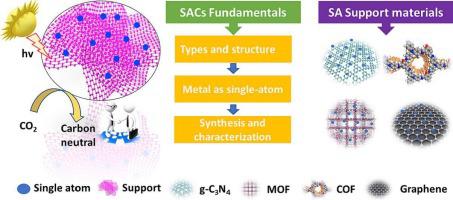Advances in Colloid and Interface Science ( IF 15.6 ) Pub Date : 2023-12-10 , DOI: 10.1016/j.cis.2023.103068 Syed Najeeb-Uz-Zaman Haider , Waqar Ahmad Qureshi , Rai Nauman Ali , Rao Shaosheng , Ahmad Naveed , Amjad Ali , Maria Yaseen , Qinqin Liu , Juan Yang

|
The persistent issue of CO2 emissions and their subsequent impact on the Earth's atmosphere can be effectively addressed through the utilization of efficient photocatalysts. Employing a sustainable carbon cycle via photocatalysis presents a promising technology for simultaneously managing the greenhouse effect and the energy dilemma. However, the efficiency of energy conversion encounters limitations due to inadequate carrier utilization and a deficiency of reactive sites. Single-atom catalysts (SACs) have demonstrated exceptional performance in efficiently addressing the aforementioned challenges. This review article commences with an overview of SAC types, structures, fundamentals, synthesis strategies, and characterizations, providing a logical foundation for the design and properties of SACs based on the correlation between their structure and efficiency. Additionally, we delve into the general mechanism and the role of SACs in photocatalytic CO2 reduction. Furthermore, we furnish a comprehensive survey of the latest advancements in SACs concerning their capacity to enhance efficiency, long-term stability, and selectivity in CO2 reduction. Carbon-structured support materials such as covalent organic frameworks (COFs), graphitic carbon nitride (g-C3N4), metal-organic frameworks (MOFs), covalent triazine frameworks (CTFs), and graphene-based photocatalysts have garnered significant attention due to their substantial surface area, superior conductivity, and chemical stability. These carbon-based materials are frequently chosen as support matrices for anchoring single metal atoms, thereby enhancing catalytic activity and selectivity. The motivation behind this review article lies in evaluating recent developments in photocatalytic CO2 reduction employing SACs supported on carbon substrates. In conclusion, we highlight critical issues associated with SACs, potential prospects in photocatalytic CO2 reduction, and existing challenges. This review article is dedicated to providing a comprehensive and organized compilation of recent research findings on carbon support materials for SACs in photocatalytic CO2 reduction, with a specific focus on materials that are environmentally friendly, readily accessible, cost-effective, and exceptionally efficient. This work offers a critical assessment and serves as a systematic reference for the development of SACs supported on MOFs, COFs, g-C3N4, graphene, and CTFs support materials to enhance photocatalytic CO2 conversion.
中文翻译:

使用碳基材料负载的单原子催化剂光催化二氧化碳还原的当代进展
通过使用高效光催化剂,可以有效解决持续存在的二氧化碳 2 排放问题及其对地球大气的影响。通过光催化实现可持续的碳循环是一种有前途的技术,可以同时管理温室效应和能源困境。然而,由于载流子利用率不足和反应位点的缺乏,能量转换的效率受到限制。单原子催化剂(SAC)在有效应对上述挑战方面表现出了卓越的性能。这篇综述文章首先概述了 SAC 的类型、结构、基本原理、合成策略和表征,根据其结构和效率之间的相关性,为 SAC 的设计和性能提供了逻辑基础。此外,我们还深入研究了 SAC 在光催化 CO 2 还原中的一般机制和作用。此外,我们还对 SAC 的最新进展进行了全面调查,了解其提高效率、长期稳定性和 CO 2 减排选择性的能力。碳结构支撑材料,如共价有机骨架(COF)、石墨氮化碳(g-C 3 N 4 )、金属有机骨架(MOF)、共价三嗪骨架(CTF)和石墨烯基光催化剂由于其巨大的表面积、优异的导电性和化学稳定性而受到广泛关注。这些碳基材料经常被选择作为锚定单个金属原子的载体基质,从而提高催化活性和选择性。 这篇综述文章背后的动机在于评估利用碳基质支撑的 SAC 进行光催化 CO 2 还原的最新进展。总之,我们强调了与 SAC 相关的关键问题、光催化 CO 2 还原的潜在前景以及现有的挑战。这篇综述文章致力于提供关于光催化 CO 2 还原中 SAC 碳支撑材料的最新研究成果的全面、有组织的汇编,特别关注环境友好、易于获取、成本低的材料。有效,而且异常高效。这项工作提供了关键的评估,并为开发支持 MOF、COF、g-C 3 N 4 、石墨烯和 CTF 支撑材料的 SAC 以增强光催化 CO 提供了系统参考。 2 转换。



























 京公网安备 11010802027423号
京公网安备 11010802027423号